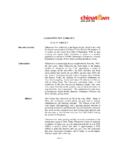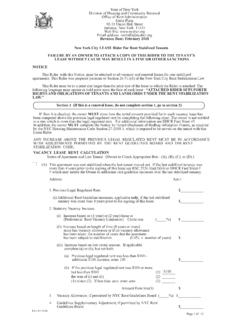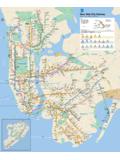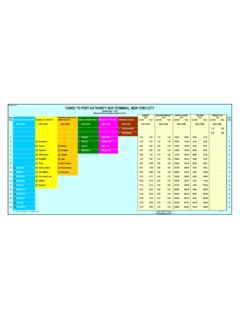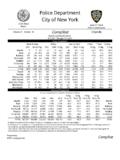Transcription of New York City’s Wastewater Treatment System
1 New york city 's Wastewater Treatment System Cleaning the Water We Use Protecting the Environment We Live In New york city Department of Environmental Protection Michael R. Bloomberg, Mayor Emily Lloyd, Commissioner List of Acronyms NYCDEP .. New york city Department of Environmental Protection NYSDEC .. New york State Department of Environmental Conservation NYCDOS .. New york city Department of Sanitation USEPA .. United States Environmental Protection Agency NYPA .. New york Power Authority NYCSWCD .. New york city Soil and Water Conservation District ALS .. American Littoral Society WPCP .. Water Pollution Control Plant NYOFCo .. New york Organic Fertilizer Company IPP .. Industrial Pretreatment Program PERC .. Perchloroethylene CSO .. Combined Sewer Overflow EBPP .. Enhanced Beach Protection Program MGD .. Million Gallons per Day CWA.
2 Clean Water Act PCB .. Polychlorinated Biphenols PAHs .. Poly-Aromatic Hydrocarbons BOD .. Biochemical Oxygen Demand TSS .. Total Suspended Solids DO .. Dissolved Oxygen BNR .. Biological Nutrient Removal New york city 's Wastewater Treatment System 1. Table of Contents How Water Gets to Us .. 4. History of New york city Water .. 4. Wastewater Treatment Past and Present .. 5-6. Nitrogen Control Applied Research Program .. 6. Wastewater Treatment Process .. 7-9. Preliminary Treatment Primary Treatment Secondary Treatment Disinfection Sludge Treatment Thickening Digestion Sludge Dewatering Beneficial Use of Biosolids .. 9. How Biosolids Are Used .. 10-11. Land Application Composting Alkaline Treatment Heat Drying How New york city Protects Its Water Environment .. 11. Testing New york city Waterways Environmental Concerns.
3 11. Toxic Substances Pollution Control Programs .. 12-16. Industrial Pretreatment Program (IPP). Persistent Pollutant Track-down Program Perchloroethylene Program (PERC). Corrosion Control Program 2 New york city 's Wastewater Treatment System Pollution Control Programs Continued .. 12-16. Pollution Prevention Program Dry Weather Discharges Grease Pumping Station Telemetry Combined Sewer Overflows Floating Debris Water Quality Monitoring Regulatory Telemetry System / Enhanced Beach Protection Program Nutrients Water Waste Map of New york Harbor and Historical Sampling Sites .. 15. Diagram of Treatment Process .. 16-17. How You Can Make a Difference .. 18-19. Conserve Water Keep Hazardous Substance out of the Sewer System Don't Litter Use Mass Transportation Dispose of Household Grease Properly Volunteer for Shoreline Cleanup and Survey Programs Report Dry Weather Discharges Map of New york city Plant Locations and Capacities.
4 20. New york city Wastewater Treatment Plants .. 21-24. DEP Sludge Vessels .. 25. Wastewater Treatment Plants Before Modernization .. 26-30. Bureau of Wastewater Treatment Organizational Chart .. 31. How to Get in Touch with DEP .. 32. New york city 's Wastewater Treatment System 3. History of New york city Water Where does New york city 's water Where does used water go? come from? Used water goes into New york city 's extensive Each day New york city delivers about billion gallons Wastewater Treatment System . This amazing network of safe drinking water to over 8 million city residents and System that cleans our Wastewater consists of: over another 1 million consumers who live in Westchester, 6,000 miles of sewer pipes; 135,000 sewer catch basins;. Putnam, Ulster and Orange Counties north of the city . over 494 permitted outfalls for the discharge of combined The source of New york city 's drinking water is supplied sewer overflows (CSOs) and stormwater; 93 Wastewater by a network of 19 reservoirs and three controlled lakes in pumping stations that transport it to 14 Wastewater a 1,972 square-mile watershed that extends 125 miles Treatment plants located throughout the five boroughs.
5 North and west of New york city . The New york city Department of Environmental Between the water supply and Wastewater Treatment Protection (DEP), Bureau of Wastewater Treatment systems are millions of New Yorkers and visitors to the (BWT) is responsible for the operation and maintenance city and an elaborate network of sewers and water mains. of all facilities related to the Treatment of sewage. The Each person can help these systems run better by Bureau of Wastewater Treatment has 1,900 employees, an conserving water, disposing of garbage and household annual operating budget of $262 million, and an annual chemicals properly and being concerned about water capital budget of $114 million. With these resources, quality in the city 's surrounding waters. the billion gallons of Wastewater discharged by eight million residents and workers in New york city each and every day is processed at the Treatment plants.
6 After the Treatment process is completed, the plants release high- quality, treated Wastewater , called effluent, into the waterways surrounding New york city . 4 New york city 's Wastewater Treatment System Ashokan Reservoir Wastewater Treatment Past and Present efore the city 's first upstate reservoir System was to keep the beaches clean and to protect the health B was developed in 1842, New Yorkers depended on well water and enterprising street vendors . of beach goers rather than maintaining water quality. As the population grew to million, these plants for their drinking water. became overburdened. When the link was made between waterborne bacteria and diseases in humans, it was The Dutch, who first settled on the lower tip of recognized that a master plan was needed to study and Manhattan, got their water from ponds, streams and protect the surrounding waterways.
7 As a result, in 1904, shallow wells. As the population multiplied, the demand the Metropolitan Sewerage commission was created. The for fresh water grew. With no System for disposing of commission undertook harbor surveys and water quality sewage and garbage, human and animal waste polluted analysis. It performed studies of the tides, studied the the water supply, causing frequent epidemics of contagious harbor's natural flushing action, and developed a city waterborne diseases, such as yellow fever and cholera. It Master Plan for Wastewater Treatment plants. The plan soon became abundantly clear that something had to be included construction of Treatment plants to meet the done to rid NYC streets of human and animal waste needs of the growing population and identify the and trash. optimum locations for future sites. Wastewater Treatment began in New york city in the late Between 1935 and 1945 three new plants were 1890s and early 1900s at two locations in Brooklyn and constructed Wards Island in Manhattan and Bowery one in Queens.
8 These became the 26th Ward, the Coney Bay and Tallman Island in Queens. The Wards Island Island Water Pollution Control plants (WPCP) in plant was built to handle flows from the east side of Brooklyn and the Jamaica WPCP in Queens. Because Manhattan and the lower part of the Bronx. This plant, of the tremendous use of the city public beaches, these which came on line in 1936, was the first to use the three areas were considered a high priority. Wastewater conventional activated sludge concept to treat sewage. Treatment consisted of chemical coagulation for settling Bowery Bay and Tallman Island also used activated as well as seasonal disinfection with chlorine. The impetus New york city 's Wastewater Treatment System 5. sludge. As the population approached million, the facility, connected to the 26th Ward plant consisting of a Coney Island, 26th Ward and Jamaica plants were 10 million gallon holding tank for storm water.
9 Upgraded. These six plants brought the citywide capacity By 1968, 12 Wastewater Treatment plants were operating for Treatment to 497 million gallons per day (mgd). in the area of New york city . They treated over one Between 1945 and 1965, five new plants were built to billion gallons a day and removed an average of 65 percent meet the needs of the continually expanding population, of pollutants from New york city Wastewater . In 1972, which was now nearing eight million. These were Hunts the federal government passed the Clean Water Act Point in the Bronx, Oakwood Beach and Port Richmond (CWA). It dictated minimum standards for Wastewater in Staten Island, and the Rockaway and Owls Head plants Treatment plants throughout the country. That meant that in Brooklyn. During this period, the older Bowery Bay, plants had to be upgraded to secondary Treatment , which Coney Island and Tallman Island plants underwent removed up to 85 percent of pollutants.
10 The CWA made upgrades. These upgrades included the newly invented people realize the importance of protecting the environ- step-aeration process where primary effluent is added ment. Upgrades were performed at eight plants, bringing incrementally into the aeration tanks thereby reducing the the citywide capacity to 1,390mgd. By 1979, nine of the detention times and allowing for a more flexible and city 's plants had been upgraded to secondary Treatment . accommodating process. With the addition of these five, there were eleven sewage Treatment plants in the city and Between 1979 and 1995, the Coney Island and Owls the citywide capacity for sewage Treatment increased from Head plants were upgraded to full secondary Treatment . 497mgd to 1,037mgd. Also during this time, two more Treatment plants were completed, the Red Hook plant in Brooklyn and the Between 1965 and 1979, the Newtown Creek Wastewater North River plant, which was positioned on a platform Treatment plant was built in Brooklyn.










